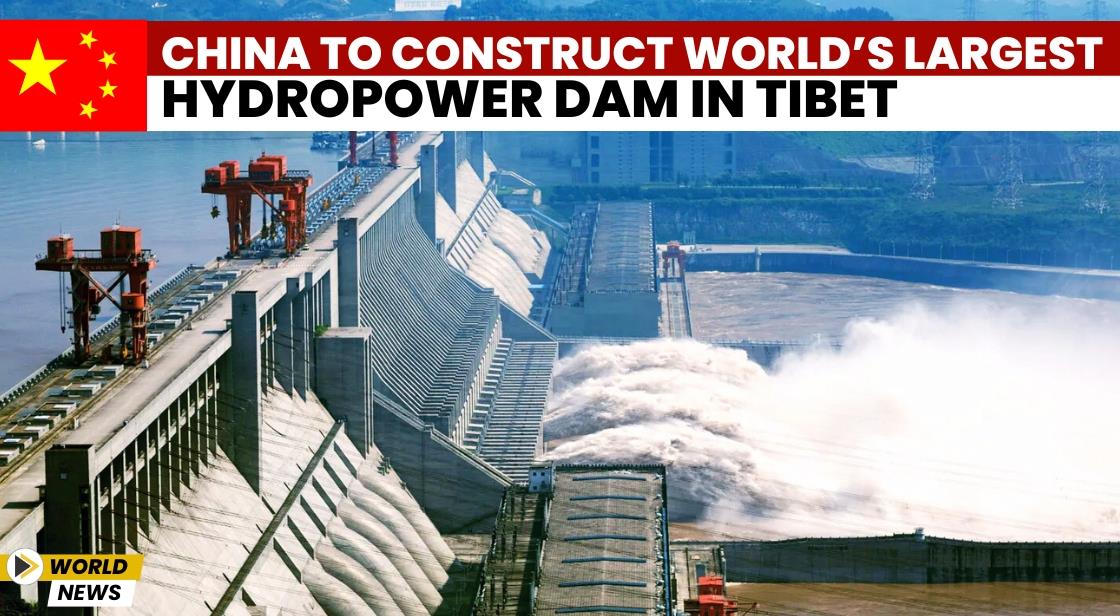China to Construct World’s Largest Hydropower Dam in Tibet

News Synopsis
China has greenlit the construction of what will soon become the world's largest hydropower dam, marking a significant milestone in its energy development agenda. This ambitious project, located on the eastern rim of the Tibetan Plateau, is set to have substantial implications for millions of people downstream, including those in India and Bangladesh.
Location and Scale of the Project
The proposed dam will be situated in the lower reaches of the Yarlung Zangbo River, a vital water source in Tibet. This site is believed to hold enormous hydropower potential due to its unique geographical features, including a section of the river that drops dramatically by 2,000 meters (6,561 feet) over a short span of 50 kilometers (31 miles).
The project promises to generate 300 billion kilowatt-hours (kWh) of electricity annually, a figure that would more than triple the output of the current largest hydropower plant, the Three Gorges Dam, located in central China.
Potential and Significance for China’s Energy Goals
The new hydropower dam is projected to play a key role in China’s efforts to meet its carbon peaking and carbon neutrality targets. By generating a substantial amount of clean energy, it will contribute to the country’s broader environmental goals. Furthermore, the dam is expected to stimulate industries related to hydropower, including engineering, while also creating jobs in Tibet, according to reports from the official Xinhua news agency.
Engineering and Financial Challenges
The Yarlung Zangbo’s dramatic topography, coupled with the hydroelectric potential of the area, presents both opportunities and significant engineering challenges. The construction outlay for this project is expected to surpass that of the Three Gorges Dam, which cost 254.2 billion yuan ($34.83 billion), including expenses for resettling over 1.4 million displaced individuals. While the exact cost of the new dam has yet to be disclosed, it is anticipated to be a multi-billion-dollar endeavor.
Displacement and Ecological Concerns
One of the major concerns surrounding the construction of the world’s largest hydropower dam in Tibet is the potential displacement of local populations. Although authorities have not yet indicated how many people will be affected, the project’s environmental impact is a matter of ongoing debate. Tibet’s local ecosystem is known for its richness and diversity, and there are fears that the dam may disrupt this delicate balance.
Despite these concerns, Chinese officials have assured that the hydropower projects in Tibet, which are estimated to hold over a third of China’s hydroelectric power potential, will not severely impact the environment or downstream water supplies. However, the project still raises important questions regarding its long-term consequences for the region.
Concerns from India and Bangladesh
India and Bangladesh, two countries situated downstream of Tibet’s Yarlung Zangbo River, have expressed concerns over the construction of the dam. The Yarlung Zangbo River becomes the Brahmaputra as it flows southward into India, passing through the northeastern states of Arunachal Pradesh and Assam before reaching Bangladesh.
These nations are worried that the dam could alter the river’s flow and course, potentially leading to negative ecological and water supply consequences in their territories.
Current Hydropower Projects and Future Plans
China has already initiated hydropower generation on the upper reaches of the Yarlung Zangbo, with plans for additional projects upstream. These ongoing developments, combined with the massive dam being constructed in Tibet, point to a growing focus on hydropower as a crucial element of China’s energy infrastructure. However, as hydropower projects continue to expand, it remains to be seen how they will affect neighboring countries and the broader regional environment.
Conclusion
The construction of the world’s largest hydropower dam on the Yarlung Zangbo River in Tibet marks a monumental step in China’s energy development strategy. While it promises to significantly boost China’s clean energy production and help meet its carbon neutrality goals, the project raises important questions about its environmental and social impacts. The potential displacement of local populations and its effects on the delicate ecosystem of Tibet are major concerns that need careful consideration.
Furthermore, the downstream nations, India and Bangladesh, are closely monitoring the project, fearing disruptions to the Brahmaputra River’s flow and potential consequences for their water supplies. As China continues to pursue its ambitious hydropower agenda, it will be crucial to balance the benefits of clean energy with the protection of regional ecosystems and the livelihoods of affected communities. The full impact of this massive project will unfold over the coming years, as it brings both opportunities and challenges for the region and beyond.









